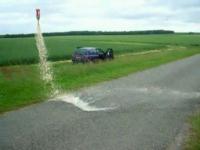The Mentosoda Rocket Experiment
To obtain this :
which in just one word is :
Just follow these simple steps :
A=> put a mentos packet into a 1.5 liter (or more) bottle of soda - you can pour a little soda before inserting the mentos, in order to lower the fluid level in the bottle
B=> close the bottle VERY FAST, as when the liquid touches the first mentos, the pressure will immediately start to increase (or should i say the volume of foam ;-))
C=> then you have a rocket ready to be ignited !
D=> ignition is generally provided by the cap of the bottle being ejected JUST AFTER you've thrown violently the bottle toward the ground (see the video here http://mentosoda.free.fr)
Ignitions Tips
- you need hard ground, don't do that in the house nor in the shed of course, because you can't imagine how fun it is to see it hIIIIIIIIIIIIIgh and fAAAAAAAst !!!
- you'll probably need several tries before you achieve your goal : in other words, there's no magic explanation as "how to throw the bottle", yet i can outline one rule : the harder you throw it, the better the chances are that it'll work
- remember that ideally, the propulsion force must be provided (like in a kinda jet-engine) by the pressured soda inside the bottle being suddenly ejected through the small aperture of the bottleneck.
Explanation Section
For the moment i haven't spent time to investigate the chemical explanation of the foam volume increase when soda meets mentos.
However, you can browse these pages for further info :
Yet, i think the cap-ejection process happens because most often the weakest part of the recipient is the threaded part of the bottleneck, where the cap is screwed onto the bottle (thus achieving the airtightness characteristic we need to allow the pressure containment before the ignition is triggered).
When the recipient hits the ground, the inside volume of the bottle decreases a little bit because of the deformation, consequently the pressure increases a little bit more, and if it increases enough, we obtain what we want :
1) the bottle bounces on the ground
2) during the deformation due to the bounce, pressure increases inside the rocket, causing the weakest part of the bottle to break down,
3) the following ACTION
[soda being ejected through the breakage]
implies the following REACTION
[a propulsion force is applied to the bottle by the soda, in the opposite direction of the soda flow]
4) the path of the rocket is determined by the attitude of the bottle when propulsion starts, and by the direction of the soda flow relatively to the bottle, during the propulsion
NB1 : the force applied by the soda to the bottle starts to decrease immediately after the soda has begun ejecting. In other words, the maximum propulsion force is obtained just after the bounce, at the moment the bottle breaks down while "hanging in the air" (of course, slow motion videos show that sometimes the breakage occurs while the bottle is still touching the ground)
NB2 : sometimes the bottle doesn't break down at the cap, but a crack appears elsewhere at the surface of the plastic matter
NB3 : point 4) is the reason why the experiment doesn't always work like we want, that is : rocket being driven towards the sky fast and high. But you'll soon understand what i mean ;-)
NB4 : the colder the soda is, and the more time you'll have to introduce the mentos and then close the bottle
NB5 : when the mentos are in, the warmer the soda is, and the greater the pressure will be inside the rocket : that will tend to increase the propulsion force applied to the rocket when the soda ejects
Just a few last recommandations :
- don't forget the rocket weights about 1.5 kg (that is 35 oz) or more, and it's intended to travel fAAAAAST, hIIIIIgh and fAAAAr !
- don't forget to shoot all your experiments, you never know when it's gonna work (i used my digicam)
- do not think you'll avoid soda stains : no stain no gain !! (see Fueling Incident in the video)
- use a plastic bag to collect used empty rockets
- remember, 100% fun : please edit your videos so we can only see successful launches or hilarious failures (for example, you can use Windows Movie Maker, it's included in XP)
- don't forget to visit and join http://www.frappr.com/mentosoda as soon as your video is YouTubed !!
Cheers
Hubb from Team Beauce Express
